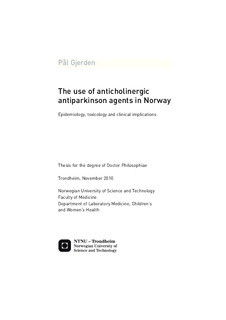| dc.contributor.author | Gjerden, Pål | nb_NO |
| dc.date.accessioned | 2014-12-19T14:19:33Z | |
| dc.date.available | 2014-12-19T14:19:33Z | |
| dc.date.created | 2010-12-15 | nb_NO |
| dc.date.issued | 2010 | nb_NO |
| dc.identifier | 378468 | nb_NO |
| dc.identifier.isbn | 978-82-471-2407-9 (printed ver.) | nb_NO |
| dc.identifier.isbn | 978-82-471-2408-6 (electronic ver.) | nb_NO |
| dc.identifier.uri | http://hdl.handle.net/11250/263812 | |
| dc.description.abstract | This thesis is based on two fundamental questions: Which patients are currently using anticholinergic antiparkinson drugs? Does it matter which anticholinergic antiparkinson drug they are using? These questions were further investigated, using a variety of methods, as follows:
Are anticholinergic antiparkinson agents predominantly used to treat Parkinson’s disease or antipsychotic induced extrapyramidal side-effects (EPS)?
Is there a high risk of abuse of anticholinergic antiparkinson agents?
Can alleged differences in receptor binding profiles of typical first- (FGA) and atypical second (SGA) -generation antipsychotic agents predict concomitant use of anticholinergic agents?
Can long-term co-prescription of anticholinergic antiparkinson agents shed some light on the efficacy of antipsychotic agents?
Does the literature indicate differences in toxicity and fatality rates of anticholinergic antiparkinson agents? Does an autopsy material indicate differences between anticholinergic agents regarding toxicity and fatality risk?
Are warnings in a medical journal against the use of the most toxic anticholinergic agent enough to reduce its use?
Can patients stop using anticholinergic agents without further remedies?
The thesis has the following conclusions:
The overwhelming majority of anticholinergic users were patients concomitantly using antipsychotic agents, presumably for the alleviation of antipsychotic induced EPS. The use of anticholinergics was not particularly skewed and we could not find any other indication of abuse, indicating that concomitant use of anticholinergics can be a proxy for the liability of specific antipsychotic agents to cause EPS.
For patients using only one antipsychotic agent, the concurrent use of anticholinergics varied between 0.4% and 26.0%, but largely independently of the distinction between typical and atypical antipsychotics. High D2-receptor antagonism and a high 5-HT2A/D 2- receptor-affinity ratio coincided with the use of anticholinergics.
Clozapine and zuclopentixol demonstrated the highest level of prescription persistence in a three-year period. The high prevalence of concomitant use of anticholinergics and zuclopentixol may indicate that the latter was considered efficacious enough to outweigh its probable side-effects. Haloperidol was associated with a mortality three times that of any other antipsychotic agent in the study.
Orphenadrine is by far the most toxic anticholinergic antiparkinson agent with a high mortality risk. Warnings in a medical journal against the use of a toxic drug can have an impact on prescription patterns.
At least one-third of the patients using anticholinergic antiparkinson agents do not need them. | nb_NO |
| dc.language | eng | nb_NO |
| dc.publisher | Norges teknisk-naturvitenskapelige universitet, Det medisinske fakultet, Institutt for laboratoriemedisin, barne- og kvinnesykdommer | nb_NO |
| dc.relation.ispartofseries | Doktoravhandlinger ved NTNU, 1503-8181; 2010:212 | nb_NO |
| dc.relation.ispartofseries | Dissertations at the Faculty of Medicine, 0805-7680; 454 | nb_NO |
| dc.relation.haspart | Gjerden, Pål; Bramness, Jørgen G; Slørdal, Lars. The use and potential abuse of anticholinergic antiparkinson drugs in Norway. British Journal of Clinical Pharmacology. (ISSN 0306-5251). 67(2): 228-33, 2009. <a href='http://dx.doi.org/10.1111/j.1365-2125.2008.03342.x'>10.1111/j.1365-2125.2008.03342.x</a>. <a href='http://www.ncbi.nlm.nih.gov/pubmed/19094158'>19094158</a>. | nb_NO |
| dc.relation.haspart | Gjerden, Pål; Slørdal, Lars; Bramness, Jørgen G. Association between the use of anticholinergic antiparkinson drugs and safety and receptor drug-binding profiles of antipsychotic agents.. European Journal of Clinical Pharmacology. (ISSN 0031-6970). 65(12): 1229-1235, 2009. <a href='http://dx.doi.org/10.1007/s00228-009-0696-6'>10.1007/s00228-009-0696-6</a>. <a href='http://www.ncbi.nlm.nih.gov/pubmed/19644682'>19644682</a>. | nb_NO |
| dc.relation.haspart | Gjerden, Pål; Slørdal, Lars; Bramness, Jørgen G. Prescription persistence and safety of antipsychotic medication. European Journal of Clinical Pharmacology. (ISSN 0031-6970). 66(9): 911-7, 2010. <a href='http://dx.doi.org/10.1007/s00228-010-0839-9'>10.1007/s00228-010-0839-9</a>. <a href='http://www.ncbi.nlm.nih.gov/pubmed/20521034'>20521034</a>. | nb_NO |
| dc.relation.haspart | Gjerden, Pål; Slørdal, L. Antikolinerge antiparkinsonmedikamenters kliniske farmakologi. En oversikt med vekt på akutt toksisitet.. Tidsskrift for Den norske legeforening. (ISSN 0029-2001). 118: 53-55, 1998. | nb_NO |
| dc.relation.haspart | Gjerden, Pål; Engelstad, KS; Pettersen, G; Slørdal, L. Dødsfallforårsaket av antikolinerge antiparkinsonmedikamenter. Analysefunn i et nasjonalt 11-årsmateriale.. Tidsskrift for Den norske legeforening. (ISSN 0029-2001). 118: 42-44, 1998. | nb_NO |
| dc.relation.haspart | Gjerden, Pål; Bramness, Jørgen G; Slørdal, Lars. Effect of warnings in a medical journal on the use of orphenadrine.. Journal of Evaluation In Clinical Practice. (ISSN 1356-1294). 14(4): 615-7, 2008. <a href='http://dx.doi.org/10.1111/j.1365-2753.2007.00912.x'>10.1111/j.1365-2753.2007.00912.x</a>. <a href='http://www.ncbi.nlm.nih.gov/pubmed/18462287'>18462287</a>. | nb_NO |
| dc.relation.haspart | Gjerden, Pål; Slørdal, Lars; Bramness, Jørgen G. The use of antipsychotic and anticholinergic antiparkinson drugs in Norway after the withdrawal of orphenadrine.. British Journal of Clinical Pharmacology. (ISSN 0306-5251). 68(2): 238-42, 2009. <a href='http://dx.doi.org/10.1111/j.1365-2125.2009.03446.x'>10.1111/j.1365-2125.2009.03446.x</a>. <a href='http://www.ncbi.nlm.nih.gov/pubmed/19694744'>19694744</a>. | nb_NO |
| dc.title | The use of anticholinergic antiparkinson agents in Norway: Epidemiology, toxicology and clinical implications | nb_NO |
| dc.type | Doctoral thesis | nb_NO |
| dc.contributor.department | Norges teknisk-naturvitenskapelige universitet, Det medisinske fakultet, Institutt for laboratoriemedisin, barne- og kvinnesykdommer | nb_NO |
| dc.description.degree | Dr.philos. | nb_NO |
| dc.description.degree | Dr.philos. | en_GB |

